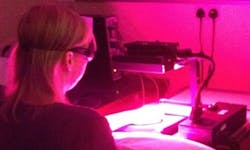At-home light therapy device shows promise as chronic ulcer treatment
The current light therapy method for treating chronic ulcers involves five-day laser treatment in the hospital and medication to lower blood pressure. Recognizing this, a team of scientists at the University of Manchester (Manchester, England) and Salford Royal NHS Foundation Trust (Salford, England) has developed a lamp that combines infrared (IR), red, and ultraviolet (UV) light and could be administered at home, with the potential for remote monitoring by a physician.
The lamp, which was designed by Stuart Watson, Head of R&D Services at Salford Royal and built by colleagues Nahzli Mir and Steven Bibby, has 32 different bulbs that emit IR, red, or UV light. Each range of light has a specific purpose: IR light is associated with increasing blood flow and oxygen; red light is believed to boost blood circulation, increasing the supply of oxygen and nutrients needed for wound healing; and UV light kills the bacteria and reduces the inflammation that prevents healing.
A study using the lamp device, led by Royal Hallamshire Hospital (Sheffield, England) consultant rheumologist Michael Hughes, tested the therapy on finger ulcers caused by systemic sclerosis (where the immune system attacks the body's fingers and toes). In the study, eight patients with 14 ulcers between them were treated using the lamp for 15-minute sessions, twice a week for three weeks. After treatment, there was an average 83% improvement in the ulcers, with no side effects.
Hughes says the device has potential as a treatment for other ulcers, including diabetic and venous ulcers. In the future, the device could be easily adapted to monitor ulcers remotely using cameras, as well as be programmed to recognize different parts of the body so that the treatment is given accurately, he says. In the next 6-12 months, he adds, the research team will be refining the machine and, within 12 months, hope to test it on diabetic ulcers.
Full details of the work appear in the Journal of Dermatological Treatment.
